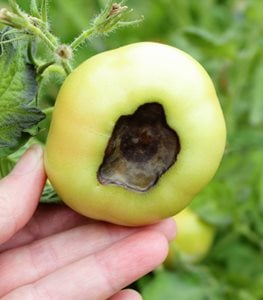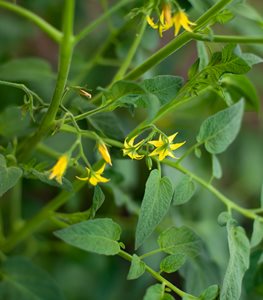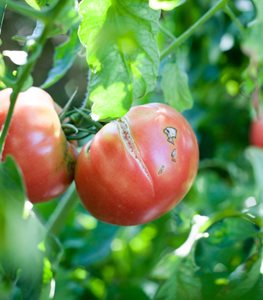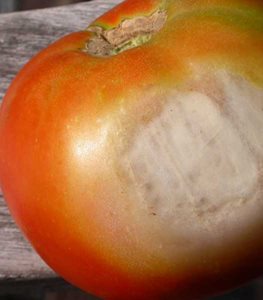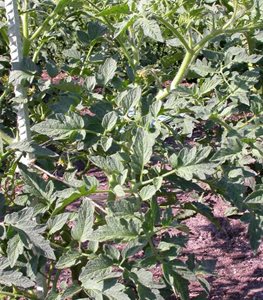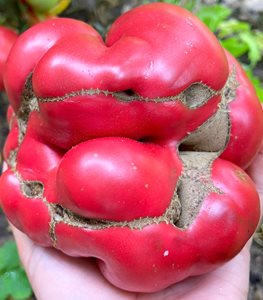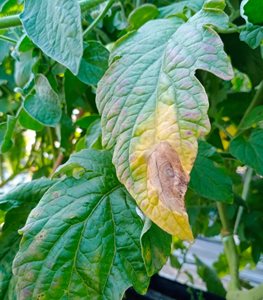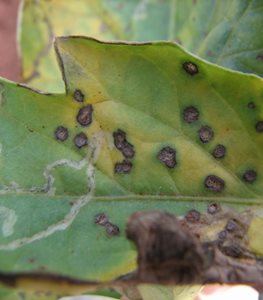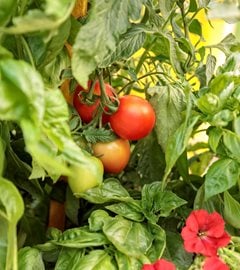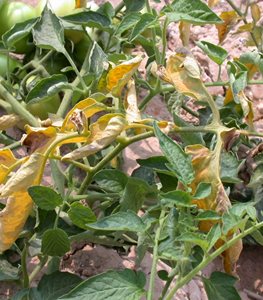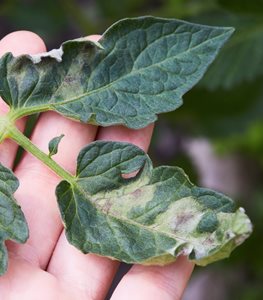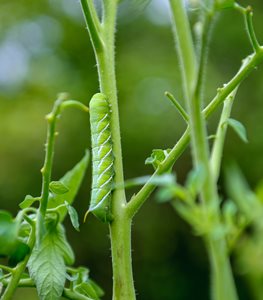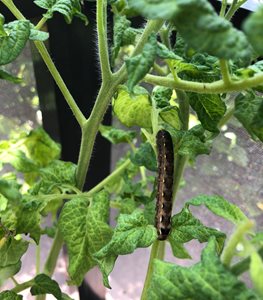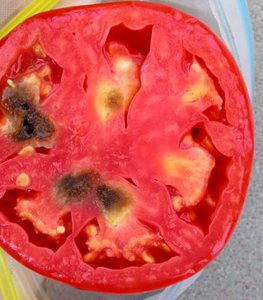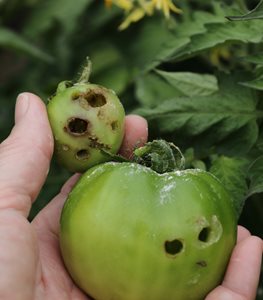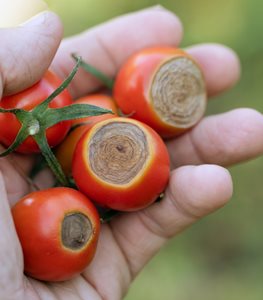TOMATO PLANT DISEASES, PESTS, AND PROBLEMS
Troubleshoot common problems with tomato plantsWhile there are many diseases and pests that can affect tomato plants, the most common threats are fungal diseases. Causes include improper watering, excess humidity, overcrowding, and poor air circulation. Remedy these issues, keep planting areas free of debris, plant disease-resistant varieties, and you will increase your chances of having healthy and productive tomato plants.
TOMATO TROUBLESHOOTING
BLACKENED FRUIT ENDS
This is likely due to blossom end rot, which signals a calcium deficiency. Uneven watering practices, too much nitrogen, and temperature fluctuations are contributing factors.
Solutions:
- Dispose of affected fruits and provide regular, deep waterings.
- Use a fertilizer that is lower in nitrogen and high in phosphorus.
- Check your soil pH before the growing season and adjust calcium content by adding lime, gypsum, or crushed eggshells to the soil.
BLOSSOM DROP
Flowers drop off the plant without fruit development. This is usually caused by extreme temperature fluctuations. Tomatoes need nighttime temperatures between 55-75 degrees F to successfully set flowers and fruit. Other causes include not enough water, insect damage, lack of pollination, and too much or too little nitrogen.
Solutions:
- Use warming aids on cooler nights.
- Adjust watering and fertilizer.
- Plant tomato companion plants or flowers nearby to deter pests and attract pollinators.
FRUIT CRACKING
Skin and flesh separate, introducing disease and compromising fruit quality. Heavy rainfall can cause fruit swelling, which leads to cracking.
Solutions:
- Cover plants or harvest ripe fruit before a heavy rain.
- Provide consistent water through the growing season.
- Cherry tomatoes are more prone to cracking, so should be harvesting just before fully ripened.
WHITE OR YELLOW PATCHES ON FRUIT
As fruits develop and ripen, yellow patches form on the skin, turning white and becoming paper-thin. This creates an unattractive appearance and poor flavor. This is likely due to sun scalding.
Solutions:
- Leave enough branches and foliage to shade fruit.
- Provide other protection from direct sun during the hottest part of the day.
POOR FRUIT SET
Plants exhibit some flowers, few or no tomatoes, and poor fruit development. This can be caused by too much nitrogen, which causes plants to develop lots of foliage at the expense of flowers and fruit. This can also be due to lack of pollination or uneven temperatures.
Solutions:
- Test soil pH early in the season and adjust fertilizer accordingly.
- Plant flowers close by to attract insect pollinators.
- Space plants at least two feet apart to avoid crowding, which can affect pollination.
DEFORMED TOMATOES WITH VEINING
Fruits are irregularly shaped with brown scarring. This is due to catfacing, which is caused by blossom drop when temperatures fall too low. This primarily affects the first tomatoes that develop. It doesn’t affect the flavor, so fruits can still be eaten once the affected parts are cut out.
Solutions:
- Plant tomatoes later in the season.
- Use a warming aid such as black plastic or row cover.
BROWN SPOTS ON LEAVES
Blemishes on leaves up to 1/2 inch diameter have tan centers with concentric rings and yellow edges. This can be an indication of early blight.
Solutions:
- Remove affected leaves as they appear and discard in the garbage; do not compost.
- Plant tomatoes in a different area the following season to prevent spread of pathogens.
MANY SMALL LEAF SPOTS
Multiple small spots (1/16 to 1/4") with dark brown edges and tan or gray centers on leaves can indicate Septoria leaf spot, one of the most devastating diseases for tomato foliage. Infection starts with the lower leaves and moves up the plant. Particularly severe in moist weather.
Solutions:
- Remove affected tomato leaves and discard; do not compost.
- Improve air circulation around the plants.
- Apply mulch to reduce splashing water on the lower leaves and water only at the base of the plant.
- Implement crop rotation and do not grow tomatoes in the same location for 1-2 years.
Tempting Tomatoes®
One of the easiest ways to ensure healthy plants is to grow disease-resistant varieties, such as:
YELLOW, WILTED PLANTS
Yellowing that begins with lower leaves and often found on one side of a plant, can be a sign of Fusarium wilt. This soil borne fungus is common in warmer regions and develops quickly in soils that are high in nitrogen and low in potassium.
Solutions:
- Remove infected plants and discard.
- Fusarium fungi can survive in the soil, on plant material, and even on tomato cages and tools for years. Soil should be removed and replaced and cages and tools cleaned thoroughly.
- Avoid applying high-nitrogen fertilizers to the soil.
- Avoid planting plants from the Solanum family in the area for a minimum of 4 years.
- Plant resistant varieties, including 'Celebrity' and 'Better Boy'.
DISCOLORED MOLDY LEAVES
Spots start out pale green, turning to brown and black. Fuzzy mold can appear on undersides of leaves. Eventually stems and fruit will also be affected. This is a sign of late blight, one of the most serious tomato diseases. An entire plant can be killed in a short amount of time.
Solutions:
- Immediately pull affected plants and place in trash rather than the compost heap to prevent disease spread.
- Select disease-resistant varieties the following season and plant in a different area.
YELLOW LOWER LEAVES
Yellow blotches appear on lower leaves, which will develop brown veining, then fall off. This signals the early stage of verticillium wilt, which is caused by soil borne pathogens, attacking the roots and moving up the plant stem. It prevents normal flow of water and nutrients to the leaves.
Solutions:
- There is no cure, and affected plants should be disposed of in the trash rather than compost.
- Don’t plant tomatoes in the same spot for four years and choose disease-resistant varieties.
Learn more: Why Are My Tomato Leaves Turning Yellow?
HOLES IN LEAVES AND SUDDEN DEFOLIATION
This can be caused by hornworms, the larvae of five-spotted hawk moths. These large caterpillars 3-4 inches long can consume a large quantity of leaves and stems, decimating an entire plant in a short amount of time.
Solutions:
- Hand pick and dispose of the worms.
- Introduce predator insects such as parasitic wasps or ladybugs, which will eat the eggs and babies.
Learn more: How to Prevent & Get Rid of Tomato Hornworms
STEM DAMAGE ON SEEDLINGS
This is likely caused by cutworms, which emerge at night and eat through the stem at nearly soil level.
Solutions:
- Make a paper collar from cardboard or newspaper and surround the stem area to keep them out.
- Remove the collar once seedlings have developed several sets of leaves.
BLACK MOLD INSIDE TOMATO
There are several possible causes, which include internal blossom end rot, anthracnose, or skin cracking that allows fungal disease to enter the fruit.
Solutions:
- Keep fruits off of soil and maintain good cultural practices.
ROUND HOLE IN FRUIT
The most common cause is tomato fruit worm, which tunnels into the center of the fruit, causing it to rot.
Solutions:
- Look for a brown caterpillar with distinct striping and dispose of the insects as well as any eggs that might be present on the foliage.
- Avoid planting near corn, which is a favorite of these worms.
- Use row covers when plants are young to keep adult moths from laying eggs.
- Dispose of any affected fruit.
DARK BULL'S EYE ON BOTTOM OF FRUIT
The large round spot is sunken and mushy to the touch. This is likely a fungus called anthracnose, which develops in hot humid weather and is aggravated by overhead watering and poor drainage. It most often affects ripe rather than green fruit, and will cause fruit to rot.
Solutions:
- Dispose of affected fruits in the trash rather than compost to prevent spread of disease.
- Make sure to water early in the morning and around the base of plants.
- Keep planting areas free of debris.
Learn more: How to Treat & Prevent Anthracnose
More on growing tomatoes:
How to Grow Tomato Plants
Different Types of Tomatoes to Grow
How to Grow Tomatoes From Seed
Staking Tomatoes: A Simple How-To Guide
Tomato Gardening Tips
